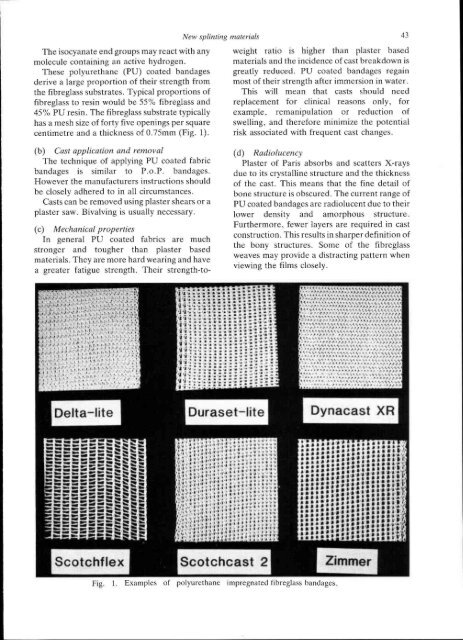View Complete Issue PDF
View Complete Issue PDF
View Complete Issue PDF
You also want an ePaper? Increase the reach of your titles
YUMPU automatically turns print PDFs into web optimized ePapers that Google loves.
New splinting materials<br />
The isocyanate end groups may react with any<br />
molecule containing an active hydrogen.<br />
These polyurethane (PU) coated bandages<br />
derive a large proportion of their strength from<br />
the fibreglass substrates. Typical proportions of<br />
fibreglass to resin would be 55% fibreglass and<br />
45% PU resin. The fibreglass substrate typically<br />
has a mesh size of forty five openings per square<br />
centimetre and a thickness of 0.75mm (Fig. 1).<br />
(b) Cast application and removal<br />
The technique of applying PU coated fabric<br />
bandages is similar to P.O.P. bandages.<br />
However the manufacturers instructions should<br />
be closely adhered to in all circumstances.<br />
Casts can be removed using plaster shears or a<br />
plaster saw. Bivalving is usually necessary.<br />
(c) Mechanical properties<br />
In general PU coated fabrics are much<br />
stronger and tougher than plaster based<br />
materials. They are more hard wearing and have<br />
a greater fatigue strength. Their strength-toweight<br />
ratio is higher than plaster based<br />
materials and the incidence of cast breakdown is<br />
greatly reduced. PU coated bandages regain<br />
most of their strength after immersion in water;<br />
This will mean that casts should need<br />
replacement for clinical reasons only, for<br />
example, remanipulation or reduction of<br />
swelling, and therefore minimize the potential<br />
risk associated with frequent cast changes.<br />
(d) Radiolucency<br />
Plaster of Paris absorbs and scatters X-rays<br />
due to its crystalline structure and the thickness<br />
of the cast. This means that the fine detail of<br />
bone structure is obscured. The current range of<br />
PU coated bandages are radiolucent due to their<br />
lower density and amorphous structure;<br />
Furthermore, fewer layers are required in cast<br />
construction. This results in sharper definition of<br />
the bony structures. Some of the fibreglass<br />
weaves may provide a distracting pattern when<br />
viewing the films closely.<br />
Fig.<br />
1. Examples of polyurethane impregnated fibreglass bandages.
















